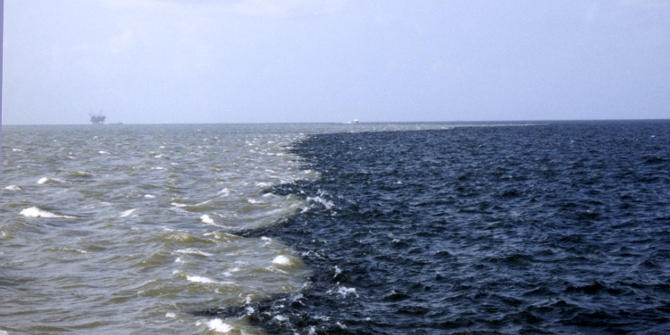Amy Larkin’s book seeks to explore environmental damages and pin their costs on the actors who caused them. This new, rather refreshing argument, and quite practical approach, is the book’s key strength, concludes Luba Pirgova.
 Environmental Debt: The Hidden Costs of a Changing Global Economy. Amy Larkin. Palgrave Macmillan. 2013.
Environmental Debt: The Hidden Costs of a Changing Global Economy. Amy Larkin. Palgrave Macmillan. 2013.
Did you know that saving the environment can mean more money for businesses as well as individuals? In Environmental Debt, Amy Larkin, an award-winning entrepreneur and environmental activist, introduces her practical Nature Means Business framework, based on the following paradigms: “1) Pollution can no longer be free and can no longer be subsidized; 2) The long view must guide all decision making and accounting; and 3) Government plays a vital role in catalyzing clean technology and growth while preventing environmental destruction” (pp. 7-8)
This framework, Larkin argues, is in sharp contrast to the business practices that are accepted widely today, where pollution is free to the polluter, the focus is on short term profits rather than long term development of the company, and governments tend to either support big businesses regardless of environmental damages caused or not get involved at all. Larkin calls for a much more hands-on approach where responsibility is given to those who do environmental damage. This is a call for transparency and a situation where the reparations of any incurred damage should be taken out of profits. This responsibility is paired with more government support for environmentally friendly practices and sanctions for ones that are not. Finally, both the government and the business sectors should always be guided by the long view that includes the ramifications that would be needed many years from now for the current environmental damages caused.
In order to make the link between environment and business a bit more explicit, it is worth noting that the World Economic Forum has identified the top three threats to financial health as 1) financial market instability including both income disparity and chronic fiscal imbalances; 2) climate change and particularly rising greenhouse gas emissions; and 3) water scarcity (see Global Risks Report, Eight Edition p. 10). Two of these are environmental and the third – financial market stability – could be argued is a by-product of environmental as well as organizational instability. The pattern held for the World Economic Forum 2014 Report as well with environment related risks being 4 out of the top 10 (see Global Risks Report, Ninth Edition, p. 9).

Larkin’s book is divided into 8 chapters. Chapter 1 develops the Nature Means Business framework, with Chapter 2 exploring the notion of environmental debt and Chapter 3 depicting the quest for true profits. These are terms that Larkin explores and defines in great detail, which will be useful for readers new to the topic. For example, environmental debt is defined as:
“polluting and/or damaging actions that will cost other parties (people, businesses or governments) real money in the future … this debt can linger for eons, disrupting complex systems of all kinds – financial, social and environmental – that support both life and livelihood.” (pp. 5 and 19)
Larkin argues that to account for environmental debt is to account for true profits, or profits obtained once the cost of the environmental debt is subtracted from the net profits of the company that has created the debt in the first place. Environmental debt costs do not just disappear, but are instead picked up by ‘the victims’, or the people, businesses and government who then have to balance the checkbook by paying for environmental damages such as water contamination, material damages due to flooding as the result of de-forestation, and ecosystem damage as well as health costs incurred such as asthma, black lung disease, and cancer and so on. Larkin’s framework would enable for environmental debt to be accounted for and true profits to be documented.
The concept of a debt is well chosen for the illustration of Larkin’s argument for two main reasons. First, the term debt implies two temporal dimensions – a short and a long view. For example, as Larkin writes, we pay today for environmental damage done in the past; as was the case with the Thailand flooding, made worst due to severe de-forestation carried out many years ago. This also means that the damage that is done in our lifetime is what our children will have to pay for in the future. This is therefore a call for both a reflection over the current environmental damage experienced, such as extreme weather events as well as a longer view such as climate change consequences. Second, the term debt implies the aggregated costs, or interest that accumulates over time. This is particularly prudent when we consider that damage done today is not a constant, but can have rippling ramifications into other eco-systems. The choice of terminology thus invites the reader to consider multiple layers of meaning and their consequences.
Other chapters focus on several examples where Larkin’s framework has already been rolled out to a degree due to the courage exhibited by certain government officials such as the politicians behind the Clean Air Act of 1973, as well as the initiatives taken up by several big companies such as Tiffany & Co, Walmart, and Unilever. The final chapter is a direct call to action and provides a guide on how to preserve the environment while maintaining profits.
Larkin has written a vast ranging book that can act as a tool for addressing individual as well as institutional roles in pushing for a more sustainable living while maintaining comfortable living standards. With plenty of examples that also include companies that have already applied Larkin’s framework, the book and its online counterpart provide a ‘to do list’ for anyone interested in environmental preservation while maintaining, and arguably even improving, business interests and profits.
Contrary to other climate change books where there is a call for reduction of energy consumption and social behavioral changes, Larkin’s book seeks to explore the environmental ramifications and pin their costs on the actors who caused them. This new, rather refreshing argument, and quite practical approach, is the book’s key strength.
This review originally appeared at the LSE Review of Books.
Please read our comments policy before commenting.
Note: This article gives the views of the authors, and not the position of USApp– American Politics and Policy, nor of the London School of Economics.
Shortened URL for this post: http://bit.ly/1pwbdIm
——————————————–
Luba Pirgova is currently enrolled in the PhD program of the Psychology department at Cardiff University, where she is affiliated with the social psychology, the understanding of risk, and ethnography, culture and interpretative analysis research groups, as well as the Energy Biographies project. Luba has an MA (Hons) in Sociology, International Relations, and Film and Visual Culture from the University of Aberdeen, Scotland. She also has an MPhil in Modern Society and Global Transformations from the University of Cambridge.






